A Micro-Nuclear Power Generator for Space Missions
Abstract
1. Introduction
2. Research Design
- Identify and gather technical specifications for the MMRTG and Li-ion battery to be integrated to determine the electrical characteristics, power output, and capacity of the MMRTG and Li-ion battery.
- Develop mathematical models for the MMRTG and Li-ion battery based on their electrical characteristics and performance parameters, incorporate appropriate equations to represent the heat generation and energy conversion processes in the MMRTG, and use established models for Li-ion batteries considering the battery internal resistance, charge, and discharge rates and voltage–current characteristics.
- Establish a MATLAB model that integrates the MMRTG and Li-ion battery systems, define the power flow between the MMRTG and battery accounting for the charging and discharging processes, and incorporate control algorithms of the power converters to manage the power transfer, and optimize system performance.
- Simulate and analyze the simulation results to evaluate the performance of the developed hybrid system and compare the performance of the hybrid system with standalone MMRTG and Li-ion battery to determine the limitations and benefits of the integration.
2.1. Adopted System Description
2.2. Modeling of Hybrid Electrochemical-Nuclear Battery
2.2.1. Modeling of the Li-Ion Battery
- is the internal resistance,
- Tref is the nominal ambient temperature,
- T is the cell temperature or internal temperature,
- Ta is the ambient temperature,
- is the reversible voltage temperature coefficient,
- is the Maximum capacity temperature coefficient,
- α is the Arrhenius rate constant for polarization resistance;
- β is the Arrhenius rate constant for internal resistance.
2.2.2. Modeling of MMRTG
- Steady-state radioisotope thermoelectric module (the temperature distribution of the air gap is the same as the thermoelectric elements; hence, heat transfer of the thermoelectric device can be treated as approximately one-dimensional heat transfer)
- Identical configurations of the p-type and n-type thermoelectric elements (equal lengths, widths, and thicknesses)
- Materials with a similar thermal coefficient of expansion must be chosen for the thermoelectric elements because different materials will cause a thermal expansion mismatch of the materials, which will lead to severe stress, leading to the degradation and breaking of the contacts between the thermoelectric elements (p-type and n-type semiconductors) and the ceramic substrate. Using similar materials is impossible; therefore, the thermoelectric module must be designed to minimize thermal stresses.
- Thermoelectric elements are connected electrically in series and thermally in parallel.
- The thermoelectric elements’ material properties (Seebeck coefficient, thermal conductivity, and electrical conductivity) are temperature dependent.
- Uniform heat from the heat source
- Radioisotope thermoelectric module is thermal insulation packaged; hence, the heat leakage through the lateral surface is negligible.
2.2.3. Modeling of Auxiliary Components
3. Results and Discussion
4. Conclusions
Author Contributions
Funding
Institutional Review Board Statement
Informed Consent Statement
Data Availability Statement
Conflicts of Interest
References
- Fakham, H.; Lu, D.; Francois, B. Power Control Design of a Battery Charger in a Hybrid Active PV Generator for Load-Following Applications. IEEE Trans. Ind. Electron. 2011, 58, 85–94. [Google Scholar] [CrossRef]
- Becherif, M. Passivity-Based Control of Hybrid Sources: Fuel Cell and Battery; IFAC: Geneva, Switzerland, 2006; Volume 11, ISBN 9783902661135. [Google Scholar]
- Ambrosi, R.M.; Williams, H.; Watkinson, E.J.; Barco, A.; Mesalam, R.; Crawford, T.; Bicknell, C.; Samara-Ratna, P.; Vernon, D.; Bannister, N.; et al. European Radioisotope Thermoelectric Generators (RTGs) and Radioisotope Heater Units (RHUs) for Space Science and Exploration. Space Sci. Rev. 2019, 215, 55. [Google Scholar] [CrossRef]
- Obodovskiy, I. Atomic Energy Sources. In Radiation: Fundamentals, Applications, Risks, and Safety; Elsevier: Amsterdam, The Netherlands, 2019; pp. 361–365. ISBN 9780444639790. [Google Scholar]
- Zoui, M.A.; Bentouba, S.; Stocholm, J.G.; Bourouis, M. A Review on Thermoelectric Generators: Progress and Applications. Energies 2020, 13, 3606. [Google Scholar] [CrossRef]
- Abd El-Hameed, A.M. Radiation Effects on Composite Materials Used in Space Systems: A Review. NRIAG J. Astron. Geophys. 2022, 11, 313–324. [Google Scholar] [CrossRef]
- Azeem, M.M.; Wang, Q.; Li, Z.; Zhang, Y. Dislocation-Oxide Interaction in Y2O3 Embedded Fe: A Molecular Dynamics Simulation Study. Nucl. Eng. Technol. 2020, 52, 337–343. [Google Scholar] [CrossRef]
- Mustafa Azeem, M.; Li, Z.; Wang, Q.; Zubair, M. Molecular Dynamics Studies and Irradiation Effects in ODSS Alloys. Int. J. Nucl. Energy Sci. Technol. 2018, 12, 381–399. [Google Scholar] [CrossRef]
- NASA Radioisotope Thermoelectric Generator. Space Radioisotope Power Systems. Available online: https://science.nasa.gov/about-us/smd-programs/radioisotope-power-systems#:~:text=The Radioisotope Power Systems (RPS,enable future space exploration missions (accessed on 16 June 2015).
- Chou, S.K.; Yang, W.M.; Chua, K.J.; Li, J.; Zhang, K.L. Development of Micro Power Generators—A Review. Appl. Energy 2011, 88, 1–16. [Google Scholar] [CrossRef]
- Ghamaty, S.; Bass, J.C.; Elsner, N.B. Quantum Well Thermoelectric Devices and Applications. In Proceedings of the 22nd International Conference on Thermoelectrics, ICT, La Grande Motte, France, 17–21 August 2003; pp. 563–566. [Google Scholar]
- Gulian, A.; Wood, K.; Fritz, G.; Gyulamiryan, A.; Nikogosyan, V.; Giordano, N.; Jacobs, T.; Van Vechten, D. X-Ray/UV Single Photon Detectors with Isotropic Seebeck Sensors. Nucl. Instrum. Methods Phys. Res. Sect. A Accel. Spectrometers Detect. Assoc. Equip. 2000, 444, 232–236. [Google Scholar] [CrossRef]
- NASA. General Purpose Heat Source|Thermal Systems—NASA RPS: Radioisotope Power Systems. Available online: https://rps.nasa.gov/power-and-thermal-systems/thermal-systems/general-purpose-heat-source/ (accessed on 15 April 2023).
- NASA. Multi-Mission Radioisotope Thermoelectric Generator (MMRTG). Available online: https://mars.nasa.gov/internal_resources/788/ (accessed on 10 April 2023).
- Jouhara, H.; Żabnieńska-Góra, A.; Khordehgah, N.; Doraghi, Q.; Ahmad, L.; Norman, L.; Axcell, B.; Wrobel, L.; Dai, S. Thermoelectric Generator (TEG) Technologies and Applications. Int. J. Thermofluids 2021, 9, 100063. [Google Scholar] [CrossRef]
- Sethumadhavan, S.; Burger, D. Powering a Cat Warmer Using Bi2Te3 Thin-Film Thermoelectric Conversion of Microprocessor Waste Heat. In Proceedings of the ASPLOS, San Jose, CA, USA, 21–25 October 2006. [Google Scholar]
- Rowe, D.M. Thermoelectrics, an Environmentally-Friendly Source of Electrical Power. Renew. Energy 1999, 16, 1251–1256. [Google Scholar] [CrossRef]
- Jaziri, N.; Boughamoura, A.; Müller, J.; Mezghani, B.; Tounsi, F.; Ismail, M. A Comprehensive Review of Thermoelectric Generators: Technologies and Common Applications. Energy Rep. 2020, 6, 264–287. [Google Scholar] [CrossRef]
- Streb, A.J. Radioisotope Power Systems for Manned Space Stations; Academic Press Inc.: Cambridge, MA, USA, 1966; Volume 16. [Google Scholar]
- Ragheb, M. Radioisotopes Power Production. Available online: https://mragheb.com/NPRE 402 ME 405 Nuclear Power Engineering/Radioisotopes Power Production.pdf (accessed on 13 April 2023).
- Riaz, A.; Sarker, M.R.; Saad, M.H.M.; Mohamed, R. Review on Comparison of Different Energy Storage Technologies Used in Micro-Energy Harvesting, Wsns, Low-Cost Microelectronic Devices: Challenges and Recommendations. Sensors 2021, 21, 5041. [Google Scholar] [CrossRef]
- Marsh, R.A.; Vukson, S.; Surampudi, S.; Ratnakumar, B.V.; Smart, M.C.; Manzo, M.; Dalton, P.J. Li Ion Batteries for Aerospace Applications. J. Power Sources 2001, 97–98, 25–27. [Google Scholar] [CrossRef]
- Ratnakumar, B.V.; Smart, M.C.; Ewell, R.C.; Whitcanack, L.D.; Chin, K.B.; Surampudi, S. Lithium-Ion Rechargeable Batteries on Mars Rovers. In Proceedings of the 2nd International Energy Conversion Engineering Conference, Providence, RI, USA, 16–19 August 2004; Volume 3, pp. 1763–1770. [Google Scholar]
- NASA. JPL|Electrochemical Technology—Mission Support. Available online: https://electrochem.jpl.nasa.gov/?page=mission-support (accessed on 15 April 2023).
- Miao, Y.; Hynan, P.; Von Jouanne, A.; Yokochi, A. Current Li-Ion Battery Technologies in Electric Vehicles and Opportunities for Advancements. Energies 2019, 12, 1074. [Google Scholar] [CrossRef]
- Ratnakumar, B.V.; Smart, M.C.; Kindler, A.; Frank, H.; Ewell, R.; Surampudi, S. Lithium Batteries for Aerospace Applications: 2003 Mars Exploration Rover. J. Power Sources 2003, 119–121, 906–910. [Google Scholar] [CrossRef]
- Clean Energy Institute Lithium-Ion Battery|Clean Energy Institute. Available online: https://www.cei.washington.edu/education/science-of-solar/battery-technology/ (accessed on 18 May 2023).
- Shepherd, C.M. Design of Primary and Secondary Cells. J. Electrochem. Soc. 1965, 112, 657. [Google Scholar] [CrossRef]
- SATNOW LP 33450—EaglePicher Technologies|Satellite Battery. Available online: https://www.satnow.com/products/batteries/eaglepicher-technologies/98-1276-lp-33450 (accessed on 25 April 2023).
- Jaguemont, J.; Boulon, L.; Dubé, Y. A Comprehensive Review of Lithium-Ion Batteries Used in Hybrid and Electric Vehicles at Cold Temperatures. Appl. Energy 2016, 164, 99–114. [Google Scholar] [CrossRef]
- Gao, F.; Tang, Z. Kinetic Behavior of LiFePO4/C Cathode Material for Lithium-Ion Batteries. Electrochim. Acta 2008, 53, 5071–5075. [Google Scholar] [CrossRef]
- Petzl, M.; Kasper, M.; Danzer, M.A. Lithium Plating in a Commercial Lithium-Ion Battery—A Low-Temperature Aging Study. J. Power Sources 2015, 275, 799–807. [Google Scholar] [CrossRef]
- Gunawardhana, N.; Dimov, N.; Sasidharan, M.; Park, G.J.; Nakamura, H.; Yoshio, M. Suppression of Lithium Deposition at Sub-Zero Temperatures on Graphite by Surface Modification. Electrochem. Commun. 2011, 13, 1116–1118. [Google Scholar] [CrossRef]
- Masih-Tehrani, M.; Yahyaei, R. Study of Lithium Battery Thermal Effect on Battery and Hybrid Battery/Ultra-Capacitor Sizing for an Electric Vehicle. J. Eng. Technol. 2017, 6, 85–99. [Google Scholar]
- Tsai, H.L.; Lin, J.M. Model Building and Simulation of Thermoelectric Module Using Matlab/Simulink. J. Electron. Mater. 2010, 39, 2105–2111. [Google Scholar] [CrossRef]
- Holgate, T.C.; Bennett, R.; Hammel, T.; Caillat, T.; Keyser, S.; Sievers, B. Increasing the Efficiency of the Multi-Mission Radioisotope Thermoelectric Generator. J. Electron. Mater. 2015, 44, 1814–1821. [Google Scholar] [CrossRef]
- Kushwah, M.; Patra, A. PID Controller Tuning Using Ziegler-Nichols Method for Speed Control of DC Motor. Int. J. Sci. Eng. Technol. Res. 2014, 3, 2924–2929. [Google Scholar]
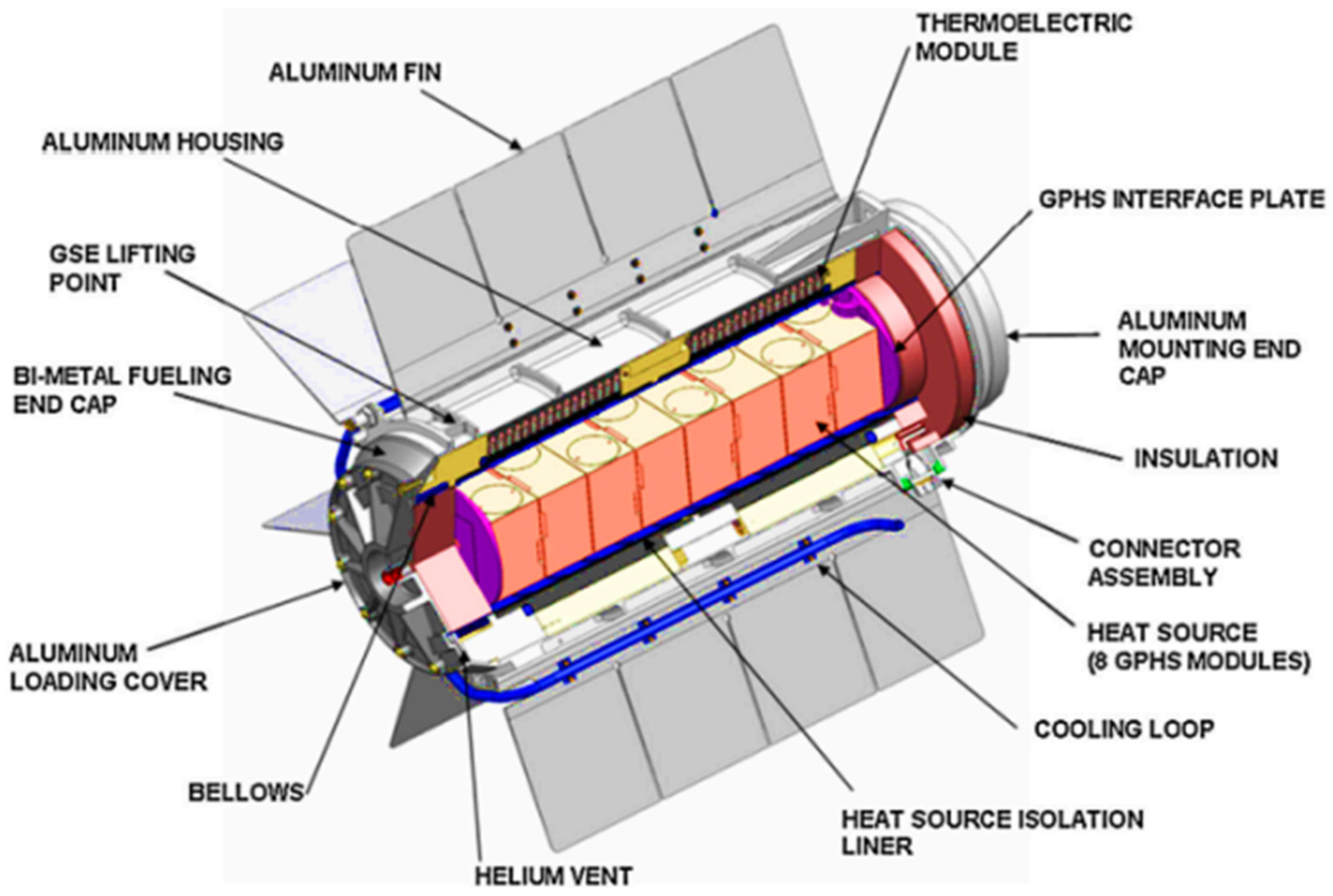


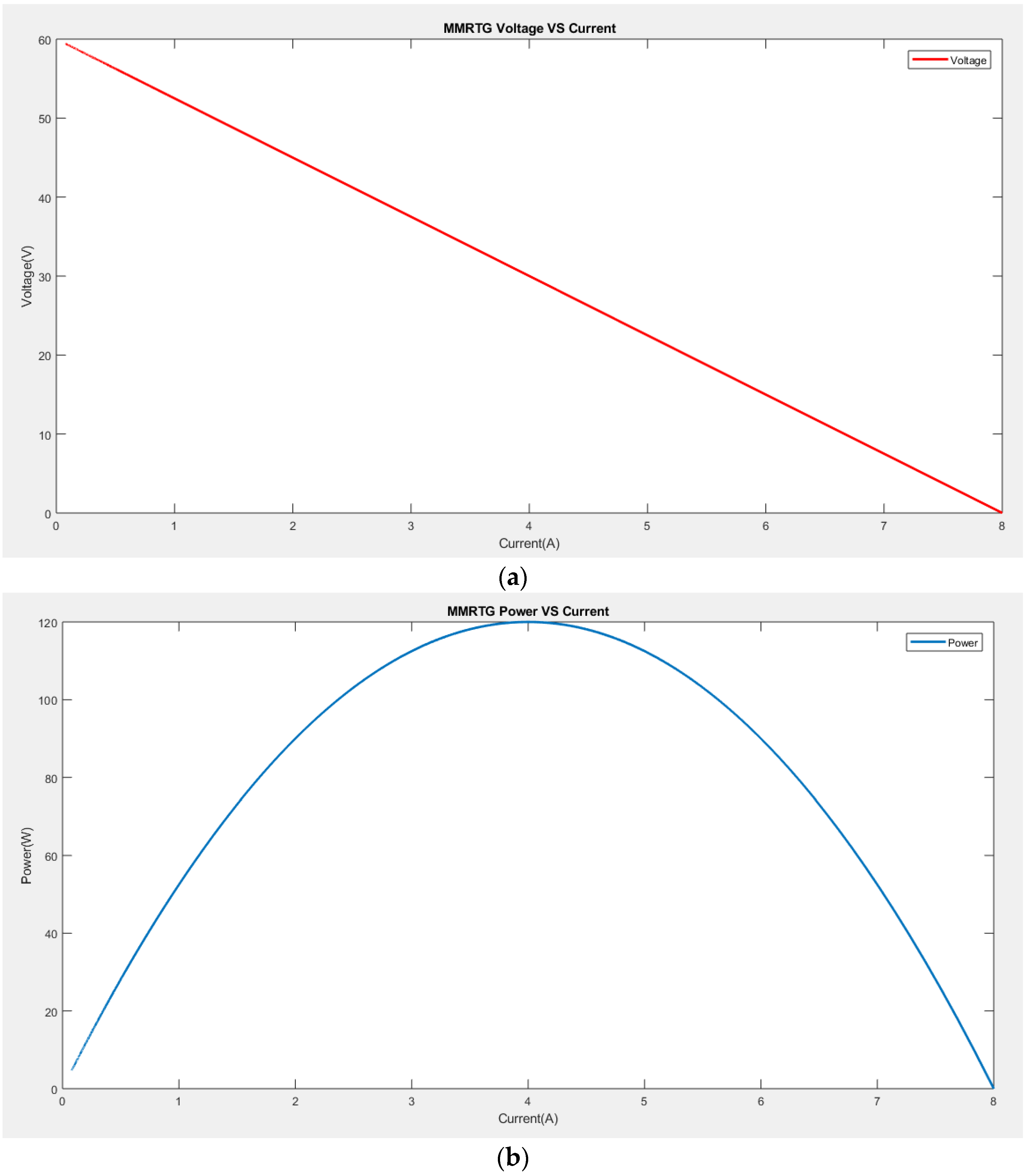
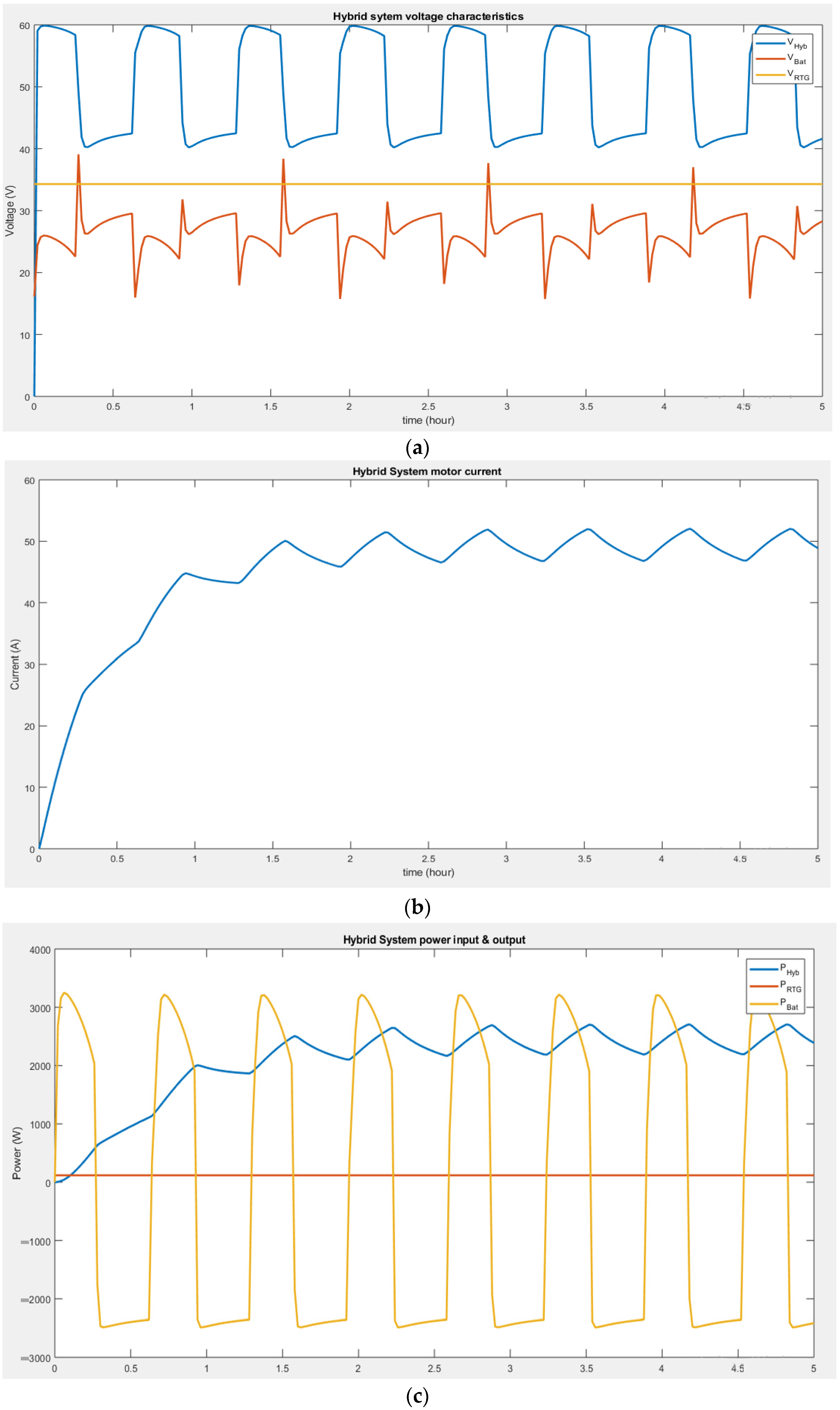
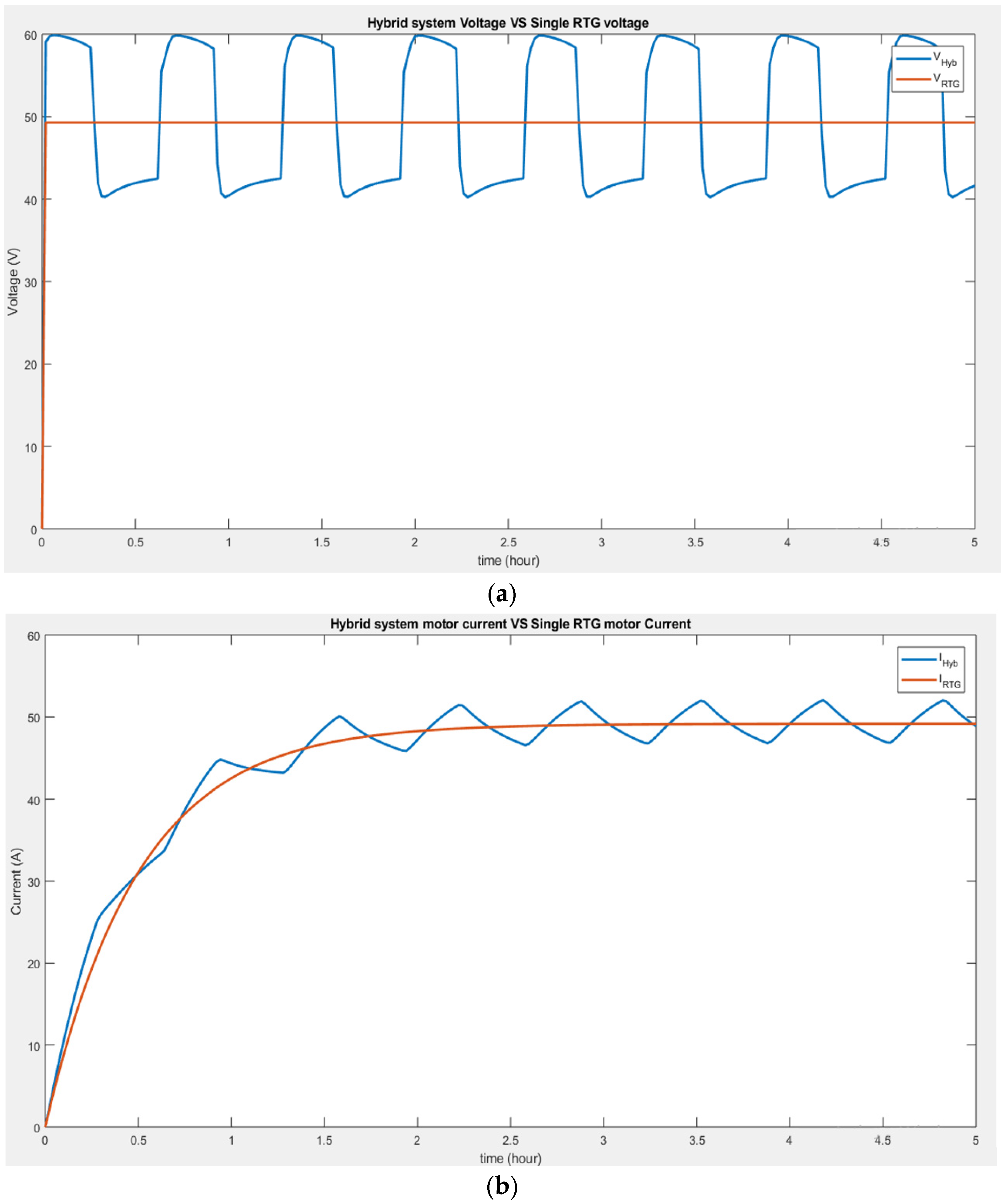
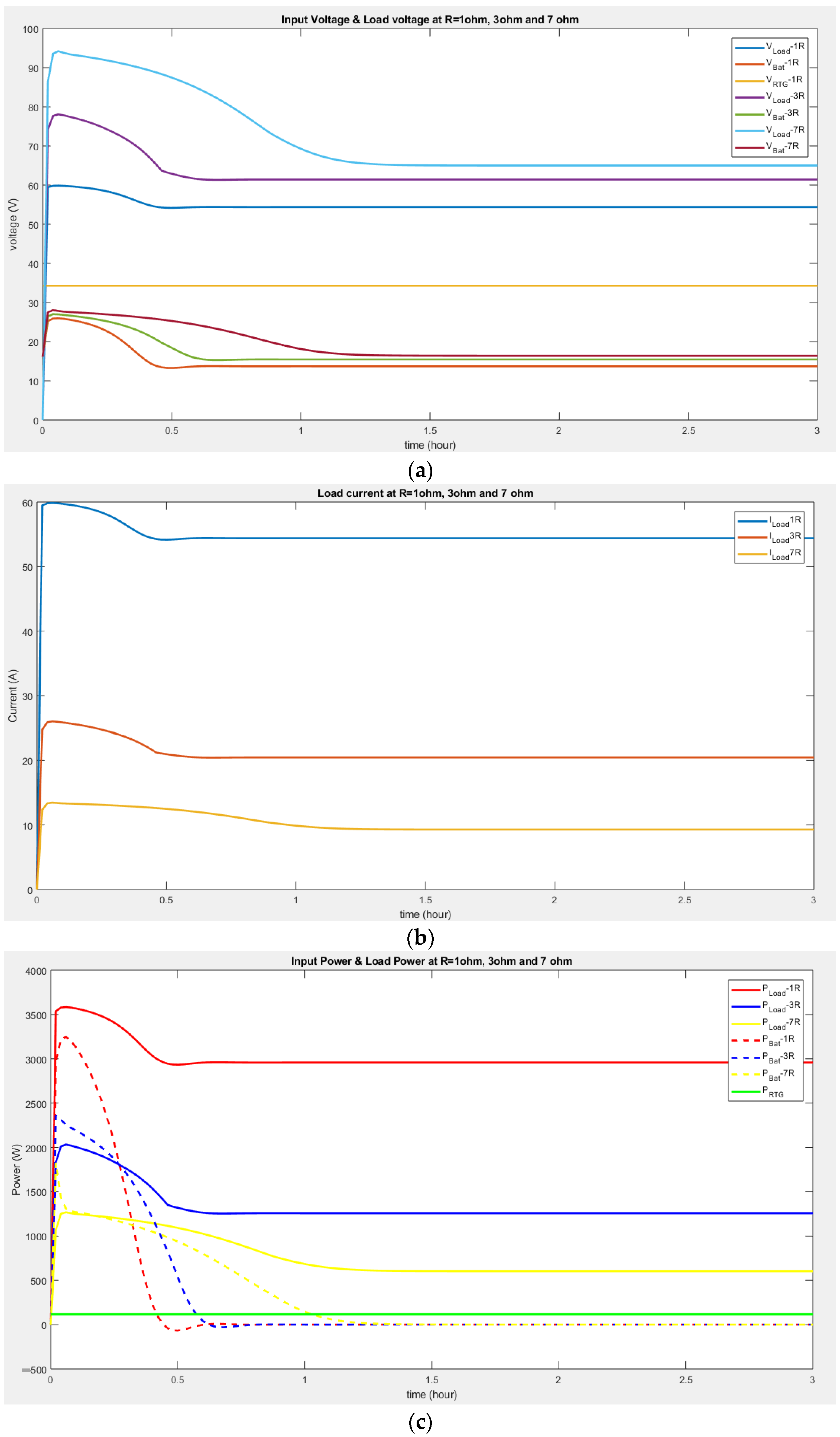
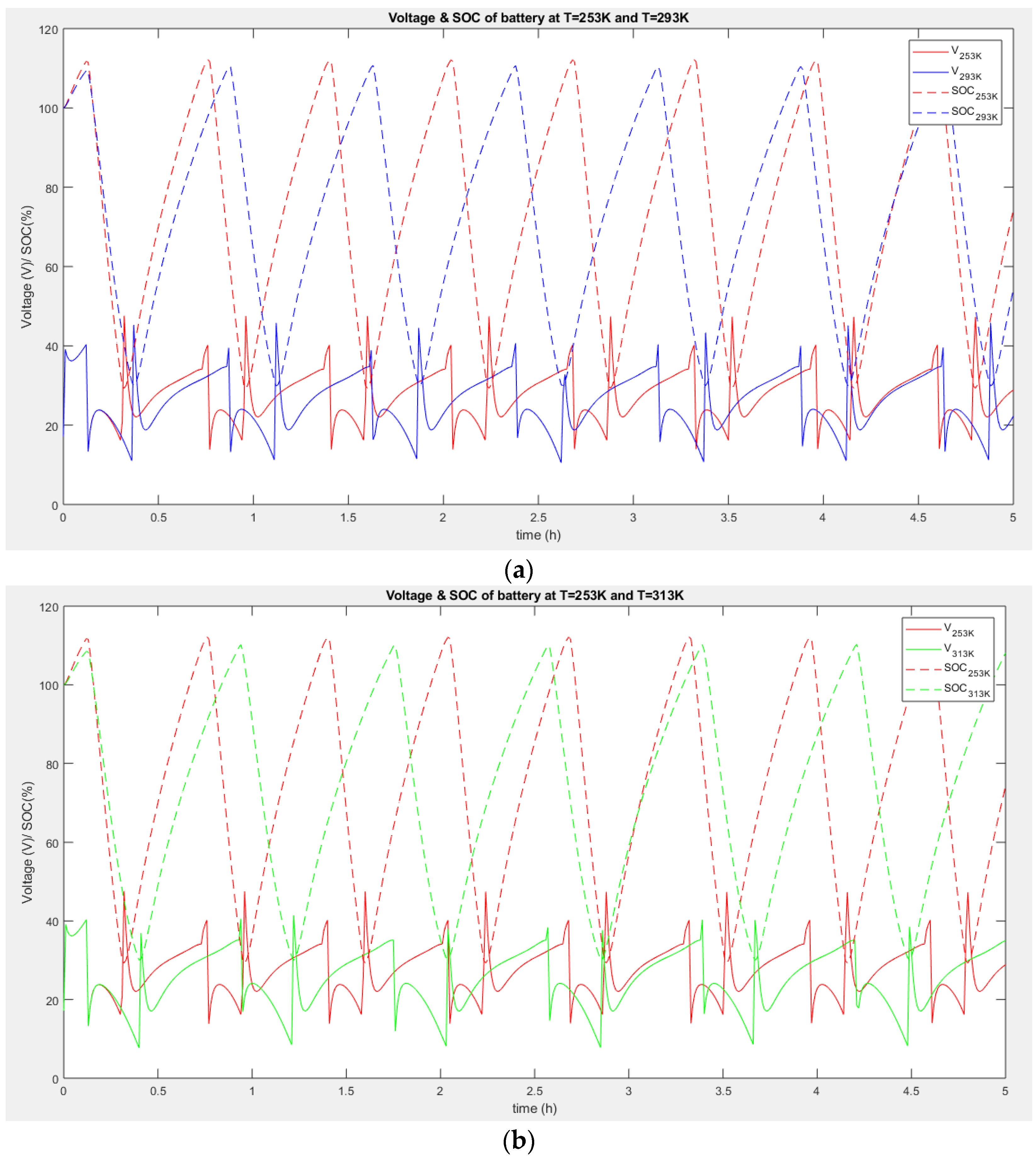
| Isotope | Main Modes of Radiation Emissions | Half-Life | Melting Point °C | Specific Power Watts (th)/gm |
|---|---|---|---|---|
| Po-210 | Alpha and few Gamma | 136.38 days | 254 | 31.7 |
| Am-241 | Alpha and Gamma | 432.2 years | 1176 | 0.11 |
| Pm-147 | Beta and few Gamma | 2.6234 years | 2375 | 0.33 |
| Sr-90 | Beta | 29 years | 770 | 0.93 |
| Pu-238 | Alpha and Gamma | 87.74 years | 640 | 0.56 |
| Ce-144 | Beta and Gamma | 284.4 days | 800 | 25.6 |
| Specifications | |
|---|---|
| Part Number | LP33450 |
| Nominal Cell Weight | 1.27 kg |
| Voltage Range | 3.0 to 4.1 V |
| Nominal Voltage | 3.6 V |
| Nominal Capacity | 43 Ah at C/5 at 20 °C (68 °F) |
| Energy Density | 378 Wh/L |
| Specific Energy | 153 Wh/kg |
| Discharge Rates | Max constant current 200 A |
| Max pulse current (< 1 s) 400 A | |
| Nominal Cell Impedance | 2 mΩ at 20 °C (68 °F) |
| Cycle Life (80% capacity measured at 0.5 C discharge current at 20 °C (68 °F)) | >2000 at 100% DOD |
| Standard Charging Method | Constant current 21.5 A (0.5 C) to 4.1 V |
| Constant voltage 4.1 V to 0.86 A (C/50) | |
| Operating Temperature | −20 to 60 °C (−4 to 140 °F) |
| Storage Temperature | −40 to 60 °C (−40 to 140 °F) |
| Design Parameters | MMRTG |
|---|---|
| No. of GPHS bricks | 8 |
| TE materials | PbTe(TAGS 85, PbSnTe) |
| No. of couples | 768 |
| Design-point QHS | 1984 WTh @ BOL |
| TE hot-side temp | 525 °C |
| TE cold-side temp | 100–200 °C |
| BOL power (WE) | ~120 |
| Est. EOL (14 years) power | 60 |
| BOL system efficiency | 6.0% |
| Specific power (WE kg−1) | 2.8 |
| Containment system | Argon overpressure |
| Mission usage | Multi-mission |
| Addressed program | MSL and Mars 2020 |
| Parameter | Value |
| Efficiency (thermal to electrical conversion) | 6.3% |
| Thermal power | 2000 W |
| Electrical power | 110 W |
| Specific power | 2.8 We/Kg |
| Output voltage | 28–32 V dc |
| Hot-side temperature | 525 °C |
| Cold-side temperature | 100–200 °C |
| Figure of merit, Z | 0.001032 Z−1 |
| Seebeck coefficient, S | 0.1818 V/K |
| Thermal conductivity, Kth | 4.271 W/K |
| Resistance, R | 7.5 Ω |
| Description | Value |
|---|---|
| Armature resistance Ra (Ω) | 1 |
| Armature inductance La (H) | 0.5 |
| Torque constant Kt | 0.01 |
| Moment of inertia J (Kg m2 S−2) | 0.01 |
| EMF constant | 0.01 |
| Friction coefficient B | 0.1 |
| Boost Converter | |
|---|---|
| Description | Value |
| MMRTE voltage (V) | 34.25 |
| Motor voltage (V) | 60 |
| Switching frequency (kHz) | 25 |
| Voltage ripple | 1% |
| Minimum inductance () | 7 |
| Minimum capacitor (mF) | 1.72 |
| Duty cycle | 43% |
| Half-bridge converter | |
| Battery voltage (V) | 30 |
| Duty cycle | 57% |
| Minimum inductance () | 15 |
| Load capacitor (mF) | 5 |
| Minimum battery capacitor (mF) | 2.3 |
Disclaimer/Publisher’s Note: The statements, opinions and data contained in all publications are solely those of the individual author(s) and contributor(s) and not of MDPI and/or the editor(s). MDPI and/or the editor(s) disclaim responsibility for any injury to people or property resulting from any ideas, methods, instructions or products referred to in the content. |
© 2023 by the authors. Licensee MDPI, Basel, Switzerland. This article is an open access article distributed under the terms and conditions of the Creative Commons Attribution (CC BY) license (https://creativecommons.org/licenses/by/4.0/).
Share and Cite
Ayodele, O.L.; Luta, D.N.; Kahn, M.T. A Micro-Nuclear Power Generator for Space Missions. Energies 2023, 16, 4422. https://doi.org/10.3390/en16114422
Ayodele OL, Luta DN, Kahn MT. A Micro-Nuclear Power Generator for Space Missions. Energies. 2023; 16(11):4422. https://doi.org/10.3390/en16114422
Chicago/Turabian StyleAyodele, Olukayode L., Doudou N. Luta, and Mohammed T. Kahn. 2023. "A Micro-Nuclear Power Generator for Space Missions" Energies 16, no. 11: 4422. https://doi.org/10.3390/en16114422
APA StyleAyodele, O. L., Luta, D. N., & Kahn, M. T. (2023). A Micro-Nuclear Power Generator for Space Missions. Energies, 16(11), 4422. https://doi.org/10.3390/en16114422








